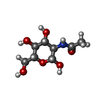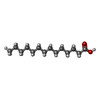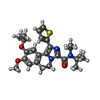+ Open data
Open data
- Basic information
Basic information
| Entry | Database: PDB / ID: 8i2g | ||||||
|---|---|---|---|---|---|---|---|
| Title | FSHR-Follicle stimulating hormone-compound 716340-Gs complex | ||||||
 Components Components |
| ||||||
 Keywords Keywords | HORMONE / Follicle stimulating hormone / FSH / GPCR / Gs-protein | ||||||
| Function / homology |  Function and homology information Function and homology informationfollicle-stimulating hormone receptor activity / regulation of platelet-derived growth factor receptor signaling pathway / regulation of acetylcholine metabolic process / progesterone biosynthetic process / : / regulation of hormone metabolic process / positive regulation of steroid biosynthetic process / follicle-stimulating hormone activity / follicle-stimulating hormone complex / pituitary gonadotropin complex ...follicle-stimulating hormone receptor activity / regulation of platelet-derived growth factor receptor signaling pathway / regulation of acetylcholine metabolic process / progesterone biosynthetic process / : / regulation of hormone metabolic process / positive regulation of steroid biosynthetic process / follicle-stimulating hormone activity / follicle-stimulating hormone complex / pituitary gonadotropin complex / luteinizing hormone secretion / follicle-stimulating hormone secretion / Thyroxine biosynthesis / Mineralocorticoid biosynthesis / adenylate cyclase-activating serotonin receptor signaling pathway / primary ovarian follicle growth / Glycoprotein hormones / Reactions specific to the complex N-glycan synthesis pathway / Hormone ligand-binding receptors / Androgen biosynthesis / follicle-stimulating hormone signaling pathway / female gamete generation / Sertoli cell proliferation / gonad development / intracellular water homeostasis / sperm DNA condensation / negative regulation of organ growth / sensory perception of chemical stimulus / Sertoli cell development / basement membrane organization / transcytosis / cellular response to follicle-stimulating hormone stimulus / regulation of systemic arterial blood pressure / regulation of osteoclast differentiation / regulation of signaling receptor activity / mu-type opioid receptor binding / corticotropin-releasing hormone receptor 1 binding / thyroid hormone generation / positive regulation of bone resorption / G protein-coupled peptide receptor activity / beta-2 adrenergic receptor binding / negative regulation of bone resorption / organ growth / positive regulation of intracellular estrogen receptor signaling pathway / female gonad development / regulation of chromosome organization / uterus development / peptide hormone binding / thyroid gland development / PKA activation in glucagon signalling / developmental growth / D1 dopamine receptor binding / Hedgehog 'off' state / adenylate cyclase-activating adrenergic receptor signaling pathway / response to prostaglandin E / hormone-mediated signaling pathway / insulin-like growth factor receptor binding / adenylate cyclase regulator activity / TFAP2 (AP-2) family regulates transcription of growth factors and their receptors / ionotropic glutamate receptor binding / transforming growth factor beta receptor signaling pathway / adenylate cyclase activator activity / locomotory behavior / female pregnancy / hormone activity / bone development / adenylate cyclase-inhibiting G protein-coupled receptor signaling pathway / Golgi lumen / platelet aggregation / G-protein beta/gamma-subunit complex binding / male gonad development / Olfactory Signaling Pathway / Activation of the phototransduction cascade / adenylate cyclase-activating G protein-coupled receptor signaling pathway / G beta:gamma signalling through PLC beta / Presynaptic function of Kainate receptors / Thromboxane signalling through TP receptor / G protein-coupled acetylcholine receptor signaling pathway / Activation of G protein gated Potassium channels / Inhibition of voltage gated Ca2+ channels via Gbeta/gamma subunits / G-protein activation / neuron projection development / Prostacyclin signalling through prostacyclin receptor / G beta:gamma signalling through CDC42 / Glucagon signaling in metabolic regulation / G beta:gamma signalling through BTK / Synthesis, secretion, and inactivation of Glucagon-like Peptide-1 (GLP-1) / ADP signalling through P2Y purinoceptor 12 / photoreceptor disc membrane / Sensory perception of sweet, bitter, and umami (glutamate) taste / Glucagon-type ligand receptors / Adrenaline,noradrenaline inhibits insulin secretion / Vasopressin regulates renal water homeostasis via Aquaporins / Glucagon-like Peptide-1 (GLP1) regulates insulin secretion / G alpha (z) signalling events / cellular response to catecholamine stimulus / ADP signalling through P2Y purinoceptor 1 / ADORA2B mediated anti-inflammatory cytokines production / G beta:gamma signalling through PI3Kgamma / adenylate cyclase-activating dopamine receptor signaling pathway Similarity search - Function | ||||||
| Biological species |   Homo sapiens (human) Homo sapiens (human) | ||||||
| Method | ELECTRON MICROSCOPY / single particle reconstruction / cryo EM / Resolution: 2.8 Å | ||||||
 Authors Authors | Duan, J. / Xu, P. / Yang, J. / Ji, Y. / Zhang, H. / Mao, C. / Luan, X. / Jiang, Y. / Zhang, Y. / Zhang, S. / Xu, H.E. | ||||||
| Funding support |  China, 1items China, 1items
| ||||||
 Citation Citation |  Journal: Nat Commun / Year: 2023 Journal: Nat Commun / Year: 2023Title: Mechanism of hormone and allosteric agonist mediated activation of follicle stimulating hormone receptor. Authors: Jia Duan / Peiyu Xu / Huibing Zhang / Xiaodong Luan / Jiaqi Yang / Xinheng He / Chunyou Mao / Dan-Dan Shen / Yujie Ji / Xi Cheng / Hualiang Jiang / Yi Jiang / Shuyang Zhang / Yan Zhang / H Eric Xu /  Abstract: Follicle stimulating hormone (FSH) is an essential glycoprotein hormone for human reproduction, which functions are mediated by a G protein-coupled receptor, FSHR. Aberrant FSH-FSHR signaling causes ...Follicle stimulating hormone (FSH) is an essential glycoprotein hormone for human reproduction, which functions are mediated by a G protein-coupled receptor, FSHR. Aberrant FSH-FSHR signaling causes infertility and ovarian hyperstimulation syndrome. Here we report cryo-EM structures of FSHR in both inactive and active states, with the active structure bound to FSH and an allosteric agonist compound 21 f. The structures of FSHR are similar to other glycoprotein hormone receptors, highlighting a conserved activation mechanism of hormone-induced receptor activation. Compound 21 f formed extensive interactions with the TMD to directly activate FSHR. Importantly, the unique residue H615 in FSHR plays an essential role in determining FSHR selectivity for various allosteric agonists. Together, our structures provide a molecular basis of FSH and small allosteric agonist-mediated FSHR activation, which could inspire the design of FSHR-targeted drugs for the treatment of infertility and controlled ovarian stimulation for in vitro fertilization. | ||||||
| History |
|
- Structure visualization
Structure visualization
| Structure viewer | Molecule:  Molmil Molmil Jmol/JSmol Jmol/JSmol |
|---|
- Downloads & links
Downloads & links
- Download
Download
| PDBx/mmCIF format |  8i2g.cif.gz 8i2g.cif.gz | 658.1 KB | Display |  PDBx/mmCIF format PDBx/mmCIF format |
|---|---|---|---|---|
| PDB format |  pdb8i2g.ent.gz pdb8i2g.ent.gz | 548.9 KB | Display |  PDB format PDB format |
| PDBx/mmJSON format |  8i2g.json.gz 8i2g.json.gz | Tree view |  PDBx/mmJSON format PDBx/mmJSON format | |
| Others |  Other downloads Other downloads |
-Validation report
| Summary document |  8i2g_validation.pdf.gz 8i2g_validation.pdf.gz | 1.6 MB | Display |  wwPDB validaton report wwPDB validaton report |
|---|---|---|---|---|
| Full document |  8i2g_full_validation.pdf.gz 8i2g_full_validation.pdf.gz | 1.7 MB | Display | |
| Data in XML |  8i2g_validation.xml.gz 8i2g_validation.xml.gz | 54.6 KB | Display | |
| Data in CIF |  8i2g_validation.cif.gz 8i2g_validation.cif.gz | 79.3 KB | Display | |
| Arichive directory |  https://data.pdbj.org/pub/pdb/validation_reports/i2/8i2g https://data.pdbj.org/pub/pdb/validation_reports/i2/8i2g ftp://data.pdbj.org/pub/pdb/validation_reports/i2/8i2g ftp://data.pdbj.org/pub/pdb/validation_reports/i2/8i2g | HTTPS FTP |
-Related structure data
| Related structure data |  35135MC  8i2hC M: map data used to model this data C: citing same article ( |
|---|---|
| Similar structure data | Similarity search - Function & homology  F&H Search F&H Search |
- Links
Links
- Assembly
Assembly
| Deposited unit | 
|
|---|---|
| 1 |
|
- Components
Components
-Protein , 4 types, 4 molecules ARXY
| #1: Protein | Mass: 30168.227 Da / Num. of mol.: 1 / Mutation: S205T Source method: isolated from a genetically manipulated source Source: (gene. exp.)   Homo sapiens (human) Homo sapiens (human)Gene: GNAS, GNAS, GNAS1 / Production host:  |
|---|---|
| #5: Protein | Mass: 76683.680 Da / Num. of mol.: 1 / Mutation: S273I Source method: isolated from a genetically manipulated source Source: (gene. exp.)  Homo sapiens (human) / Gene: FSHR / Production host: Homo sapiens (human) / Gene: FSHR / Production host:  |
| #6: Protein | Mass: 10183.753 Da / Num. of mol.: 1 / Mutation: F17L Source method: isolated from a genetically manipulated source Source: (gene. exp.)  Homo sapiens (human) / Gene: CGA / Cell line (production host): HEK293 / Production host: Homo sapiens (human) / Gene: CGA / Cell line (production host): HEK293 / Production host:  Homo sapiens (human) / References: UniProt: P01215 Homo sapiens (human) / References: UniProt: P01215 |
| #7: Protein | Mass: 12241.914 Da / Num. of mol.: 1 Source method: isolated from a genetically manipulated source Source: (gene. exp.)  Homo sapiens (human) / Gene: FSHB / Cell line (production host): HEK293 / Production host: Homo sapiens (human) / Gene: FSHB / Cell line (production host): HEK293 / Production host:  Homo sapiens (human) / References: UniProt: P01225 Homo sapiens (human) / References: UniProt: P01225 |
-Guanine nucleotide-binding protein ... , 2 types, 2 molecules BG
| #2: Protein | Mass: 37915.496 Da / Num. of mol.: 1 Source method: isolated from a genetically manipulated source Source: (gene. exp.)  Homo sapiens (human) / Gene: GNB1 / Production host: Homo sapiens (human) / Gene: GNB1 / Production host:  |
|---|---|
| #3: Protein | Mass: 7861.143 Da / Num. of mol.: 1 Source method: isolated from a genetically manipulated source Source: (gene. exp.)  Homo sapiens (human) / Gene: GNG2 / Production host: Homo sapiens (human) / Gene: GNG2 / Production host:  |
-Antibody , 1 types, 1 molecules N
| #4: Antibody | Mass: 13885.439 Da / Num. of mol.: 1 Source method: isolated from a genetically manipulated source Source: (gene. exp.)   |
|---|
-Sugars , 2 types, 5 molecules 
| #8: Polysaccharide | 2-acetamido-2-deoxy-beta-D-glucopyranose-(1-4)-2-acetamido-2-deoxy-beta-D-glucopyranose Source method: isolated from a genetically manipulated source |
|---|---|
| #12: Sugar | ChemComp-NAG / |
-Non-polymers , 4 types, 19 molecules 






| #9: Chemical | ChemComp-CLR / #10: Chemical | #11: Chemical | #13: Chemical | ChemComp-O6F / | |
|---|
-Details
| Has ligand of interest | Y |
|---|---|
| Has protein modification | Y |
-Experimental details
-Experiment
| Experiment | Method: ELECTRON MICROSCOPY |
|---|---|
| EM experiment | Aggregation state: PARTICLE / 3D reconstruction method: single particle reconstruction |
- Sample preparation
Sample preparation
| Component | Name: FSHR-Follicle stimulating hormone-compound 716340-Gs complex Type: COMPLEX / Entity ID: #1-#7 / Source: RECOMBINANT |
|---|---|
| Source (natural) | Organism:  Homo sapiens (human) Homo sapiens (human) |
| Source (recombinant) | Organism:  |
| Buffer solution | pH: 7.5 |
| Specimen | Embedding applied: NO / Shadowing applied: NO / Staining applied: NO / Vitrification applied: YES |
| Vitrification | Cryogen name: ETHANE-PROPANE |
- Electron microscopy imaging
Electron microscopy imaging
| Experimental equipment |  Model: Titan Krios / Image courtesy: FEI Company |
|---|---|
| Microscopy | Model: FEI TITAN KRIOS |
| Electron gun | Electron source:  FIELD EMISSION GUN / Accelerating voltage: 300 kV / Illumination mode: OTHER FIELD EMISSION GUN / Accelerating voltage: 300 kV / Illumination mode: OTHER |
| Electron lens | Mode: OTHER / Nominal defocus max: 2000 nm / Nominal defocus min: 800 nm |
| Image recording | Electron dose: 50 e/Å2 / Film or detector model: FEI FALCON IV (4k x 4k) |
- Processing
Processing
| CTF correction | Type: NONE |
|---|---|
| 3D reconstruction | Resolution: 2.8 Å / Resolution method: FSC 0.143 CUT-OFF / Num. of particles: 477950 / Symmetry type: POINT |
 Movie
Movie Controller
Controller




 PDBj
PDBj






































